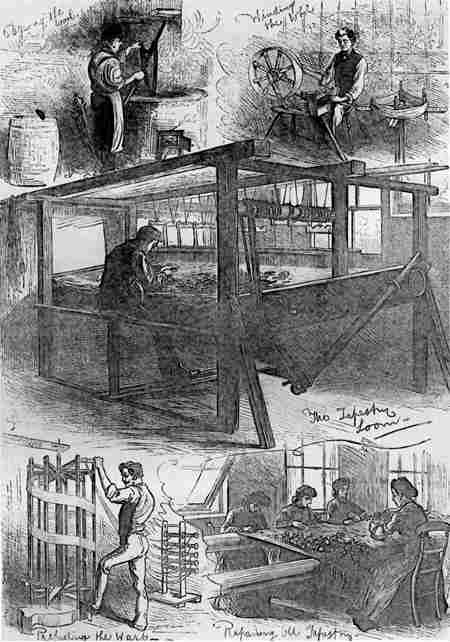What is a tapestry?
The classic misnomer is
'The Bayeux Tapestry', which is not a tapestry but embroidery
in coloured wools on coarse linen. Similarly, any design built
upon a textile fabric such as linen or canvas is not tapestry.
A true tapestry is built up in the process of weaving. The plain
warps are stretched vertically - usually between horizontal rollers-to
receive the coloured wefts which form the picture when densely
packed down by pressing with a comb-like tool as the work progresses.
The warps thus hidden form ridges in the wefts and these run
vertically while on the loom but horizontally when the tapestry
is finished and hung by its wefts after the tapestry has been
given a quarter turn into its hanging position. The warps are
stretched between rollers and this permits long sections of tapestry
to be woven-only restricted in depth by the size (width) of the
loom, which may be up to 16 feet. Tapestries deeper than this
have to be sewn together in strips.
 From a supplement
dated 29 April 1882 to the Illustrated London News
From a supplement
dated 29 April 1882 to the Illustrated London News
Work in progress at the Royal Windsor Tapestry Manufactory
Top left:
Dyeing the wool |
Top right:
Winding the wool |
| Centre: A worker at a low-warp loom |
Bottom left:
Another preparing the warp |
Bottom right:
Several women repairing old tapestry |
The warps are divided into 'odds' and 'evens' alternatively.
A division is maintained by the 'shed rod' parallel with the
top roller and actuated by means of the 'heddles' to permit the
passage of the bobbins of coloured weft. In a vertical or high
warp loom, heddles are attached only to alternate warps and the
weaver can pull these towards him. One set of warps being the
nearer by reason of the shed rod, the operation of pulling the
heddles brings the other set of warps past these towards the
weaver who can then pass between them the bobbins, and repeat
this in the other direction after releasing the heddles. The
high warp weaver is thus weaving with only one hand-the other
being required to operate the heddles. In low warp looms the
heddles are operated by pedals or treadles with one pedal operating
the 'odd' warps and the other the 'even' warps-the pair covering
about two feet sections of the width of the loom. Several weavers
can work side by side, each with a pair of pedals to operate
the warps on his section and using both hands for weaving thus
making more progress than with the high warp loom.
The high warp weaver walks round the back to inspect his work,
or uses a small mirror which hangs behind the work, so that he
can peer between the warps and view the reflection. His cartoon
hangs on the wall nearby. The low warp weaver can inspect his
work by a small mirror passed through the warps but he cannot
see much at one time. Both types of loom have the weaving done
in reverse, so that the back faces the weaver. The cartoon from
which the low warp weaver works is under the warps and is seen
through them. This permits the reproduction of the most intricate
designs with great accuracy. The word 'cartoon' comes from 'cartone'
the Italian for a large sheet of paper and a full-scale design
for work in a different material.
On primitive looms there may be no heddles and the wefts are
passed over and under the warps in a darning action. This is
also the method of repairing old tapestries.
The working of the looms however is only one aspect of tapestry
manufacture. The initial stage is the preparation of a design
for the cartoon, the latter being made the full size of the proposed
tapestry. Tapestry weaving indeed has been described as a three-fold
art, combining the skills of artists, dyers and weavers. The
weaver executes the design into cloth but it is the artist who
conceives and creates the design for the cartoon. The Raphael
cartoons displayed at the Victoria and Albert Museum on loan
from the Queen are equally if not more famous than the tapestries
made from them at the Mortlake 'atelier' which are now in Paris.
The tapestries differ as always by reason of being reverse or
mirror pictures because such tapestries are woven reverse side
uppermost, towards the weaver.
The weavers who came to Old Windsor from Aubusson, France, in
the period commencing in 1876 already had had experience of executing
tapestries from 18th century Boucher designs and cartoons. This
French artist's romantic designs were to become popular in America
after the Old Windsor works closed in 1890, no doubt because
of the migration of the French weavers from Windsor to Williamsbridge
New York.
An Introduction
to The Royal Windsor Tapestry Manufactory
ALSO SEE (External
Link)
Tapestries Direct
More about the History of Tapestry
|


